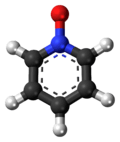Pyridine-''N''-oxide
| |||
| Names | |||
|---|---|---|---|
| IUPAC name
Pyridine-N-oxide | |||
| Other names
pyridine-1-oxide | |||
| Identifiers | |||
| 3D model (JSmol) |
|||
| ChEBI | |||
| ChemSpider | |||
| ECHA InfoCard | 100.010.705 | ||
| PubChem CID |
|||
| |||
| |||
| Properties | |||
| C5H5NO | |||
| Molar mass | 95.101 | ||
| Appearance | colourless solid | ||
| Melting point | 65 to 66 °C (149 to 151 °F; 338 to 339 K) | ||
| Boiling point | 270 °C (518 °F; 543 K) | ||
| high | |||
| Acidity (pKa) | 0.8 (of conjugate acid) | ||
| Except where otherwise noted, data are given for materials in their standard state (at 25 °C [77 °F], 100 kPa). | |||
| | |||
| Infobox references | |||
Pyridine-N-oxide is the heterocyclic compound with the formula C5H5NO. This colourless, hygroscopic solid is the product of the oxidation of pyridine. It was originally prepared using peracids as the oxidising agent.[1] The molecule is planar. The compound is used infrequently as an oxidizing reagent in organic synthesis.[2] It also serves as a ligand in coordination chemistry, and to activate the pyridine ring towards aromatic electrophilic substitution.
Synthesis and reactions
The oxidation of pyridine can be achieved with a number of peracids including peracetic acid and perbenzoic acid in a reaction that affords the protonated derivative. Subsequent treatment with heating under low pressure removes acids as gases to liberates the neutral oxide.[3] More recent reported approaches include a modified Dakin reaction using a urea-hydrogen peroxide complex,[4] and oxidation by sodium perborate[5] or, using methylrhenium trioxide (CH
3ReO
3) as catalyst, with sodium percarbonate.[6] Pyridine N-oxide is five orders of magnitude less basic than pyridine, but it is isolable as a hydrochloride salt, [C5H5NOH]Cl, via a synthesis reported in Organic Syntheses:[3]
- C5H5N + CH3C(=O)–O–OH → C5H5NO·HOOCCH3
- C5H5NO·HOOCCH3 + HCl → [C5H5NOH]Cl + CH3COOH
Considerable work has been done on synthesis of N-oxides from substituted pyridine starting materials and on chemical modifications of amine oxide systems,[7] including the chlorination of the pyridine-N-oxide with phosphorus oxychloride gives 4- and 2-chloropyridines.[8]
Safety
The compound is a skin irritant.[2]
References
- ↑ Meisenheimer, Jakob (1926). "Über Pyridin-, Chinolin- und Isochinolin-N-oxyd". Ber. Dtsch. Chem. Ges. (in German). 59 (8): 1848–1853. doi:10.1002/cber.19260590828.
- 1 2 Kilényi, S. Nicholas; Mousseau, James J. (20 September 2015). "Pyridine N-Oxide". Encyclopedia of Reagents for Organic Synthesis. John Wiley & Sons. doi:10.1002/047084289X.rp283.pub2.
- 1 2 Mosher, H. S.; Turner, L.; Carlsmith, A. (1963). "Pyridine-N-oxide". Org. Synth. doi:10.15227/orgsyn.033.0079.; Coll. Vol., 4, p. 828
- ↑ Varma, Rajender S.; Naicker, Kannan P. (1999). "The Urea−Hydrogen Peroxide Complex: Solid-State Oxidative Protocols for Hydroxylated Aldehydes and Ketones (Dakin Reaction), Nitriles, Sulfides, and Nitrogen Heterocycles". Org. Lett. 1 (2): 189–192. doi:10.1021/ol990522n.
- ↑ McKillop, Alexander; Kemp, Duncan (1989). "Further functional group oxidations using sodium perborate". Tetrahedron. 45 (11): 3299–3306. doi:10.1016/S0040-4020(01)81008-5.
- ↑ Jain, Suman L.; Joseph, Jomy K.; Sain, Bir (2006). "Rhenium-Catalyzed Highly Efficient Oxidations of Tertiary Nitrogen Compounds to N-Oxides Using Sodium Percarbonate as Oxygen Source". Synlett: 2661–2663. doi:10.1055/s-2006-951487.
- ↑ Youssif, Shaker (2001). "Recent trends in the chemistry of pyridine N-oxides". Arkivoc: 242–268.
- ↑ Scriven, E. F. V. (1984). "Pyridines and their Benzo Derivatives: (ii) Reactivity at Ring Atoms". In Katritzky, Alan R.; Rees, Charles Wayne; Meth-Cohn, Otto. Comprehensive Heterocyclic Chemistry: The Structure, Reactions, Synthesis and Uses of Heterocyclic Compounds. 2. Pergamon Press. pp. 165–314. ISBN 9780080307015. doi:10.1016/B978-008096519-2.00027-8.

